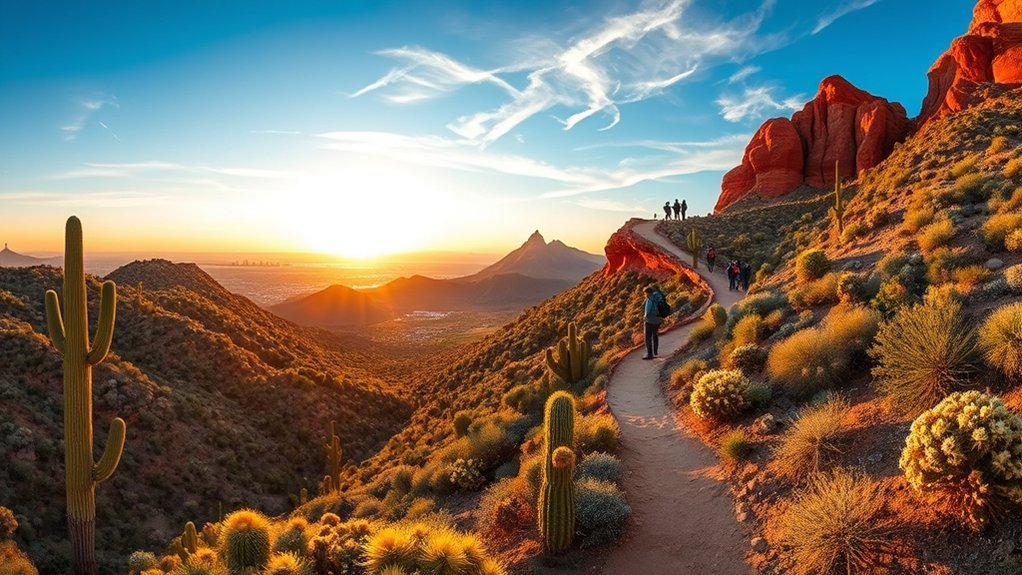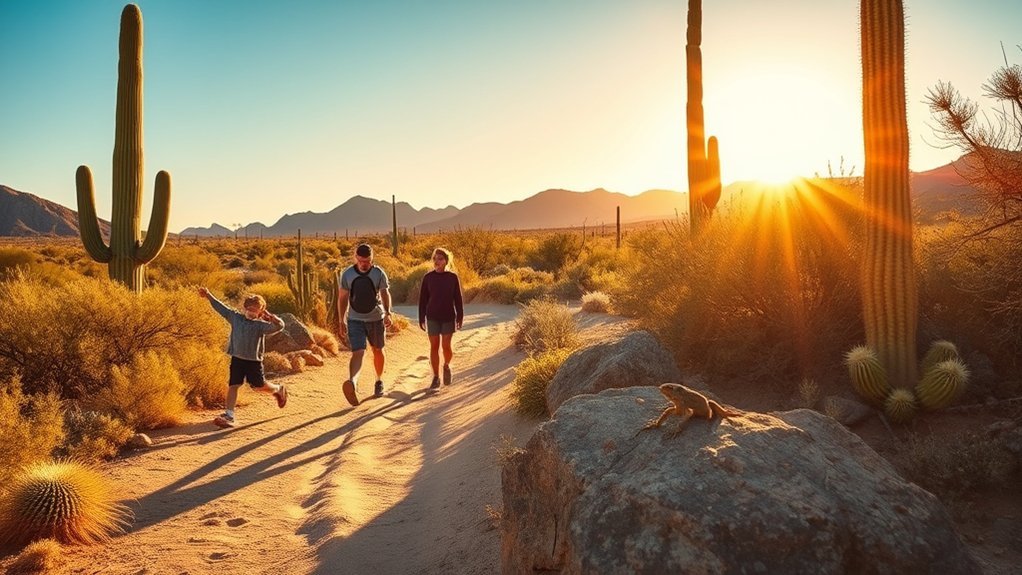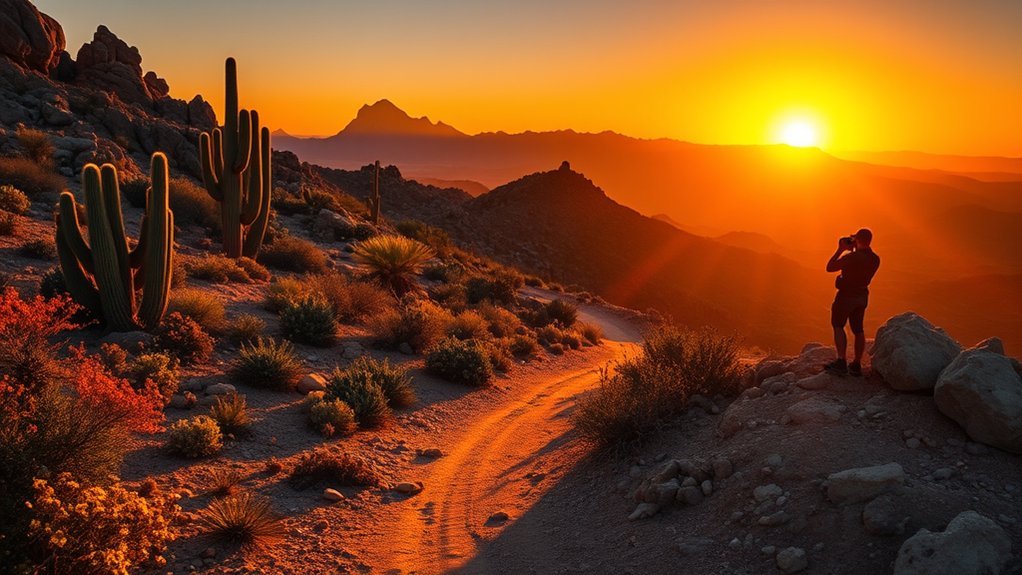If you’re looking for great hikes near Glendale, Arizona, you’ll find options from easy family strolls to steep ridgeline climbs that reward you with wide desert views. I’ll point out stroller‑friendly loops, sunrise spots, and tougher summits with practical tips on distance, footing, and best times to go. You’ll also learn where wildflowers and wildlife are most likely, plus how to link trails for longer outings—so you can pick the right route for your plans.
Top Trails Around Glendale

Get out early to beat the heat and explore a compact mix of trails that suit everything from brisk runs to full-day treks. You’ll find Cholla Loop a popular 5.5 km moderate circuit—expect lots of switchbacks, loose gravel and rocks, and an early start recommendation; its 4.5-star rating from 5,164 reviewers reflects reliable challenge and scenery. For a shorter effort with views, try Coach Whip, Ridgeline and Sunrise Loop (3.5 km), a favorite for running and hiking with rocky sections that boost fitness. If you want dramatic elevation, Thunderbird Park’s Three Peaks Loop delivers the highest ascent (11.7 km, 429 m) with diverse plants and sweeping city vistas. Arrowhead Point Trail (3.7 km) gives sunrise and sunset perks but no shade, while Deem Hills Circumference (9.3 km) tests you with technical climbs and urban access. Plan water, traction, and early starts to make the most of these well-rated options.
Short Family-Friendly Walks

Pick a trail that suits your kids’ energy and you’ll have plenty of pleasant, doable options around Glendale. You’ll find easy loops, short climbs, and suburban paths that let you tailor distance, shade, and terrain. Bring water, sun protection, and snacks; plan for strollers on packed dirt and choose rockier routes for older kids.
- Flatlander Loop — An easy 1.9 km loop in Thunderbird Conservation Park with hard‑packed dirt and gentle terrain; ideal for strollers and little legs, with connector options if you want more.
- Arrowhead Point — A moderate 3.7 km out‑and‑back; short enough for kids who can handle uneven steps, with benches at the top for breaks.
- Coach Whip/Ridgeline/Sunrise Loop — About 3.5 km of mixed suburban trail and rocky sections; good for older children building confidence on uneven ground.
- Cholla Loop short section — Pick an early, shorter segment of this 5.5 km route to enjoy switchbacks, varied scenery, and wildlife sightings without overdoing it.
Best Sunrise and Sunset Hikes

When you’re aiming for sunrise or sunset, choose trails with clear viewpoints and plan for changing light and temperatures; Arizona’s Glendale area delivers reliably dramatic skies from several accessible summits and ridgelines. For compact, reliable sunrise views head to Thunderbird Conservation Park: the Arrowhead Point Trail (3.7 km, moderate) tops out at benches where you can watch color spread over the valley—arrive early and bring layers. The Coach Whip, Ridgeline and Sunrise Loop (3.5 km) mixes rocky footing with city-to-desert panoramas and works well if you want a shorter outing or a dawn run.
For longer golden-hour exposure try Cholla Loop (5.5 km) with its switchbacks and wide vistas—start before heat builds. If you want multiple sunset angles the Three Peaks Loop in Thunderbird Park covers several summits for sweeping evening light. Across these routes pack water, wear sturdy shoes, and expect little shade and loose rock underfoot.
Challenging Climbs and Summits
Although these routes demand more fitness and focus than the easy loops, they reward you with sweeping panoramas and hard-earned summit views; be ready for sustained climbs, steep scrambles, and exposed sections.
- Thunderbird Park Three Peaks Loop — This is the toughest local summit route: 11.7 km (7.31 mi) with about 429 m (1,417 ft) of ascent. You’ll traverse three main hills and earn panoramic city viewpoints; pacing and hydration matter.
- Echo Canyon Trail (Camelback Mountain) — Expect an intense scramble: roughly 1,214 ft gain over ~2.46 mi with steep rock steps and narrow slots. Use sure footing and hands on exposed sections.
- Flatiron via Siphon Draw — A serious, longer route (~5.5 mi) with route-finding and basic climbing moves. Not for novices; bring navigation tools and be comfortable with exposure.
- North Mountain Trail / Piestewa Peak — Short, steep options (1.42–2.25 mi, 571–1,050 ft gain) that deliver quick elevation and excellent valley or sunset views; good for training efforts.
Scenic Loop Routes
You’ll find several popular loop options around Glendale, from the strenuous Thunderbird Park Three Peaks Loop with big elevation gain to shorter choices like the Flatlander Loop and mid-length circuits such as Arrowhead Point + Cholla. Pick loops that match your fitness and footing skills—Deem Hills is technical and loose underfoot, while Coach Whip/Ridgeline/Sunrise is runner-friendly but rocky. For any loop, bring plenty of water, check sunrise/sunset timing for views, and plan exit points or extensions so you can adjust distance on the fly.
Popular Loop Options
If you’re looking for scenic loops around Glendale that suit a range of abilities and timeframes, these well-marked routes deliver views, varied terrain, and easy access from town. Pick based on distance, ascent, and surface.
- Loop Trail — Flatlander Loop (1.9 km, easy, 4.3★): a short connector around Thunderbird Conservation Park, good warm-up or quick outing with easy parking.
- Coach Whip, Ridgeline and Sunrise Loop (3.5 km, moderate, 4.6★): links suburban trails, offers rocky stretches and steady exercise without a big time commitment.
- Cholla Loop (5.5 km, moderate, 4.5★): lots of switchbacks and loose gravel; start early for lower heat and better footing.
- Thunderbird Park Three Peaks Loop (11.7 km, moderate, 4.6★): longest route, biggest ascent, diverse plants, sweeping city viewpoints.
Tips for Loop Hikes
Now that you’ve seen loop options around Glendale, here are practical tips to make the most of them. Pick continuous Loop routes like Arrowhead Point and Cholla Loop (8.0 km) or Coach Whip, Ridgeline and Sunrise Loop (3.5 km) when you want no backtracking. Start early—many trails, including the Cholla Loop’s 5.5 km with switchbacks, have little shade and loose gravel that heats up. Wear sturdy footwear for mixed surfaces: hard-packed dirt, loose scree and rocky sections on Deem Hills Recreation Area routes such as the Circumference (9.3 km) and Coach Whip-to-Desert Iguana (4.0 km). Carry water, observe pet etiquette, and use short connectors like Flatlander (1.9 km) to customize distance and elevation.
Trails With the Best City Views
Often the best city vistas come from ridgelines and summits that rise above the urban sprawl, and these nearby hikes deliver clear, expansive views at sunrise and sunset. Pick a trail based on time, fitness, and how much skyline you want to soak in.
- Arrowhead Point Trail (Thunderbird Conservation Park) — 3.7 km, moderate; offers great urban trail access, rocky terrain, and benches where you can watch the sun paint the valley and city.
- Thunderbird Park Three Peaks Loop — 11.7 km, moderate; bigger effort with ≈429 m ascent, but you’ll hit multiple high points for sweeping Phoenix-area panoramas.
- Piestewa Peak Summit — 3.6 km, steep; short, intense climb with one of the most iconic skyline views in North Phoenix—best for quick sunrise missions.
- Deem Hills Circumference + Cholla/Arrowhead combo — combine sections (8–9.3 km) for technical ridgelines, exposed viewpoints, easy parking, and uninterrupted urban vistas.
Bring water, a headlamp for dawn/dusk, and check trail conditions before you go.
Desert Flora, Fauna, and Wildflower Hotspots
Beyond skyline views, Glendale’s trails open into the rich life of the Sonoran Desert, where saguaros, creosote, palo verde, cholla and ocotillo set the stage for seasonal color. You’ll find prime wildflower viewing on the Thunderbird Park Three Peaks Loop and nearby conservation routes after good winter rains, with carpets of desert primrose, lupine and chuparosa on flatter sections. Shorter loops like Cholla Loop and Arrowhead Point thread teddy-bear cholla and brittlebrush stands that attract pollinators. Deem Hills and Coach Whip ridgeline routes cover varied elevations and microhabitats, concentrating blooms February–April and following monsoon bursts. Wildlife—Gambel’s quail, desert cottontail, jackrabbits, gila woodpeckers and lizards—often forage near flowering shrubs; early-morning hikes raise your chances to see them. Because shade is limited and terrain can be loose, plan wildflower-focused outings in the morning, carry water, wear sturdy shoes, and check recent rain and flower reports for peak timing.
Multi-Use Trails for Running and Biking
Lace up or hop on and tackle Glendale’s multi‑use trails, where options span short technical loops to flat urban corridors suited for longer efforts. You’ll find routes that test footing and fitness alike, from rocky 3.5 km circuits to long, rolling circumference routes. Choose a line that matches your bike or stride, and plan for exposed sections with minimal shade.
- Coach Whip, Ridgeline and Sunrise Loop — a popular 3.5 km moderate loop with rocky sections; great for interval runs or technical mountain‑bike reps.
- Deem Hills Circumference Trail — a longer, technical ≈9.3 km option with sustained climbs and descents that challenge off‑road cyclists and serious trail runners.
- Reach 11 Trail — an urban multi‑use corridor (~10.1 km) with minimal elevation gain, ideal for steady long runs or casual rides.
- Mixed surfaces — expect hard‑packed dirt, loose gravel and rock; use sturdy shoes and a mountain or hybrid bike, and carry water for sunny outings.
Safety, Timing, and Trail Etiquette
After you pick a route—whether a short technical loop or a flat urban corridor—plan your timing and gear to match the desert conditions and trail demands. Start hikes early (before 8:00 AM in summer) to avoid midday heat on largely unshaded trails, and study trail maps so you know junctions, water access, and true distances. Carry at least 1 liter of water per hour and refill where available at trailheads that list water access; dehydration causes many incidents.
Wear sturdy shoes for mixed terrain—hard‑packed dirt, loose gravel, and rocky sections on Cholla Loop, Coach Whip, and Thunderbird—and bring trekking poles for steep or technical stretches. Check difficulty and elevation gain (Thunderbird Park Three Peaks ≈ 429 m; Coach Whip ≈ 310 m) and match routes to your fitness, allowing extra time for climbs and navigation. Practice Leave No Trace and pet etiquette: pack out trash, pick up pet waste, and yield appropriately to others for a safer, cleaner trail experience.
Connecting Longer Routes and Trail Networks
Link shorter loops and ridgelines to build longer, varied outings that match your fitness and time: for example, you can combine Thunderbird Park Three Peaks with Arrowhead Point, Cholla, or Sunrise to hit multiple summits, or use the Coach Whip system as a backbone for 15+ km adventures that mix singletrack, gravel, and technical sections. You’ll plan routes that balance climbing, flat connectors, and resupply points while noting surface changes and sparse shade.
- Use the Coach Whip Trail as a spine, linking Ridgeline, Sunrise and Desert Iguana for long runs or rides.
- Stitch Arrowhead Point (3.7 km) and Cholla (5.5 km) into an 8–10+ km Mountain Loop that keeps trailhead access.
- Extend Thunderbird Park Three Peaks (11.7 km) with nearby short loops to vary terrain and elevation gain.
- Employ Deem Hills Circumference (9.3 km) to connect neighborhoods, parking, and picnic stops for flexible turn‑around options.
Start early, carry water, and expect changing footing and limited amenities.
Frequently Asked Questions
What Is the Most Scenic Hike in Arizona?
The Flatiron via Siphon Draw is the most scenic hike in Arizona: you’ll climb to a dramatic sandstone bowl, enjoy skyline-to-desert vistas, and experience striking rock formations—be prepared for steep scrambling and variable trail conditions.
Why Is Glendale, Arizona Famous?
“Where there’s smoke, there’s fire” — you’ll know Glendale for its lively historic downtown, major events at State Farm Stadium, seasonal Glendale Glitters, and easy access to desert parks and recreational trails just outside town.
What Is the Most Famous Hike in Phoenix?
The most famous hike in Phoenix is Piestewa Peak Summit; you’ll tackle a steep 2.25-mile out-and-back, gain about 1,050 feet, and enjoy dramatic sunrise or sunset city and valley panoramas on a very popular, challenging trail.
What Are the Big 3 Thru Hikes?
You’ll tackle the “Big 3”: the Appalachian Trail (≈2,190 miles), Pacific Crest Trail (≈2,650 miles) and Continental Divide Trail (≈3,100 miles). They’re epic tests of planning, endurance, resupply logistics and season‑timed starts.
Conclusion
You’ve scoped great options—from stroller‑easy Flatlander to the grueling Thunderbird Three Peaks—so pick what fits. Pack water, sun protection, sturdy shoes, and a map; timing matters for heat and views. Start early for sunrise, or wait for the glow at sunset. Keep an eye on wildlife and respect trails. And when you’re ready to push farther, link loops into bigger circuits—because just when you think you’ve seen it all, a new ridge awaits.

